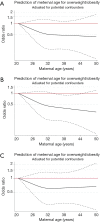Interaction between delivery mode and maternal age in predicting overweight and obesity in 1,123 Chinese preschool children
- PMID: 32395518
- PMCID: PMC7210148
- DOI: 10.21037/atm.2020.03.128
Interaction between delivery mode and maternal age in predicting overweight and obesity in 1,123 Chinese preschool children
Abstract
Background: Pediatric overweight/obesity has escalated to epidemic proportions worldwide. In this study, we aimed to assess the association of delivery mode and maternal age, both individually and interactively, with the risk of being overweight or obese among Chinese preschool children.
Methods: We cross-sectionally recruited 1,123 preschool children from five kindergartens in Beijing. Data were collected by a pre-validated self-developed questionnaire. Overweight and obesity are defined according to the World Health Organization (WHO), International Obesity Task Force (IOTF), and China criteria, respectively.
Results: Cesarean delivery was significantly associated with pediatric overweight/obesity under the WHO [adjusted odds ratio (aOR), 95% confidence interval (CI): 1.60, 1.12-2.29], IOTF (1.77, 1.23-2.53), and China (1.43, 1.06-1.94) criteria, respectively. Maternal age <28 years reached statistical significance under both WHO (1.69, 1.09-2.61) and IOTF (1.69, 1.09-2.61) criteria in predicting pediatric overweight/obesity. The interaction between cesarean delivery and maternal age <28 years was remarkably significant under the WHO (2.26, 1.10-4.67), IOTF (2.92, 1.43-5.96), and China (2.36, 1.24-4.50) criteria.
Conclusions: Our findings indicate that the interaction between cesarean delivery and maternal age <28 years can remarkably increase the risk of overweight/obesity among Chinese preschool children.
Keywords: Delivery mode; maternal age; obesity; overweight; preschool children.
2020 Annals of Translational Medicine. All rights reserved.
Conflict of interest statement
Conflicts of Interest: All authors have completed the ICMJE uniform disclosure form (available at http://dx.doi.org/10.21037/atm.2020.03.128). The authors have no conflicts of interest to declare.
Figures



Similar articles
-
Explorations on risk profiles for overweight and obesity in 9501 preschool-aged children.Obes Res Clin Pract. 2022 Mar-Apr;16(2):106-114. doi: 10.1016/j.orcp.2022.02.007. Epub 2022 Mar 9. Obes Res Clin Pract. 2022. PMID: 35277363
-
Synergistic interaction between bedtime and eating speed in predicting overweight and obesity in Chinese preschool-aged children.Aging (Albany NY). 2019 Apr 12;11(7):2127-2137. doi: 10.18632/aging.101906. Aging (Albany NY). 2019. PMID: 30978174 Free PMC article.
-
Cesarean section may increase the risk of both overweight and obesity in preschool children.BMC Pregnancy Childbirth. 2016 Nov 3;16(1):338. doi: 10.1186/s12884-016-1131-5. BMC Pregnancy Childbirth. 2016. PMID: 27809806 Free PMC article.
-
Prevalence of overweight and obesity among preschool children from six cities of northeast China.Arch Med Res. 2011 Oct;42(7):633-40. doi: 10.1016/j.arcmed.2011.10.011. Epub 2011 Nov 8. Arch Med Res. 2011. PMID: 22079860
-
Impact of Obesity during Pediatric Acute and Critical Illness.J Pediatr Intensive Care. 2015 Jun;4(2):97-102. doi: 10.1055/s-0035-1556752. J Pediatr Intensive Care. 2015. PMID: 31110858 Free PMC article. Review.
Cited by
-
Deciphering the concurrent phenomenon of childhood malnutrition by using the extended composite index of anthropometric failure (ECIAF): facts from the BESLEN project.Public Health Nutr. 2024 Dec 20;28(1):e9. doi: 10.1017/S1368980024002520. Public Health Nutr. 2024. PMID: 39702282 Free PMC article.
-
Cord blood metabolites and rapid postnatal growth as multiple mediators in the prenatal propensity to childhood overweight.Int J Obes (Lond). 2022 Jul;46(7):1384-1393. doi: 10.1038/s41366-022-01108-0. Epub 2022 May 4. Int J Obes (Lond). 2022. PMID: 35508813 Free PMC article.
-
Identifying factors associated with central obesity in school students using artificial intelligence techniques.Front Pediatr. 2022 Nov 30;10:1060270. doi: 10.3389/fped.2022.1060270. eCollection 2022. Front Pediatr. 2022. PMID: 36533227 Free PMC article.
-
Associations of parental reproductive age and elevated blood pressure in offspring: An observational study.Front Pediatr. 2023 Mar 30;11:990725. doi: 10.3389/fped.2023.990725. eCollection 2023. Front Pediatr. 2023. PMID: 37063654 Free PMC article.
-
Excessive Gestational Weight Gain: Long-Term Consequences for the Child.J Clin Med. 2020 Nov 24;9(12):3795. doi: 10.3390/jcm9123795. J Clin Med. 2020. PMID: 33255248 Free PMC article.
References
LinkOut - more resources
Full Text Sources
